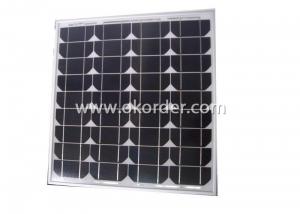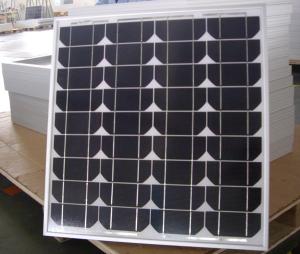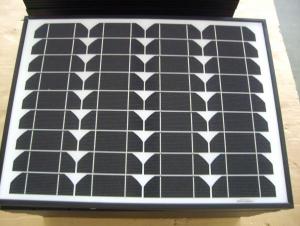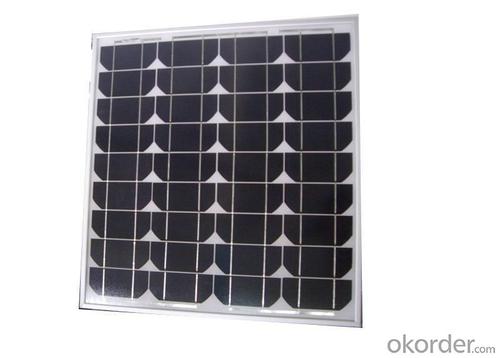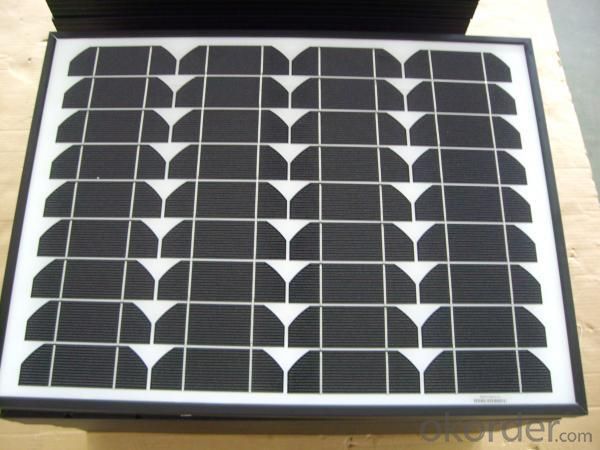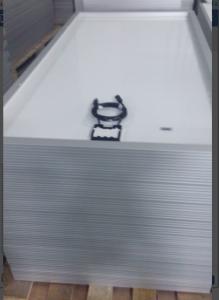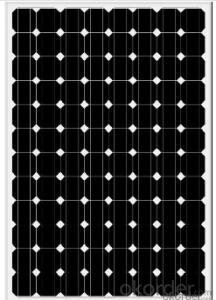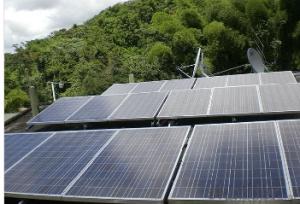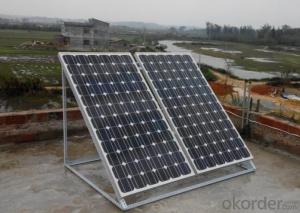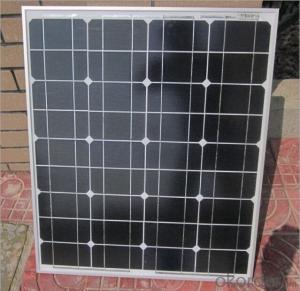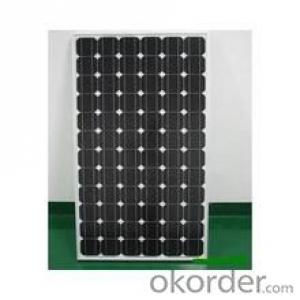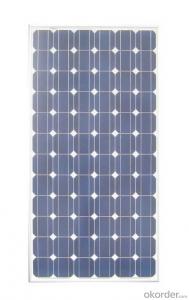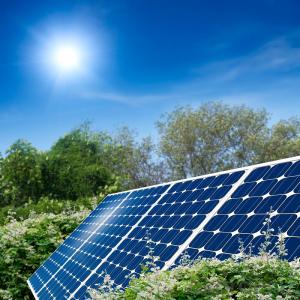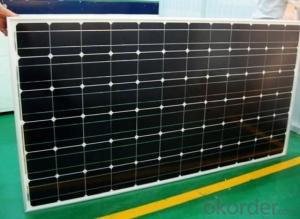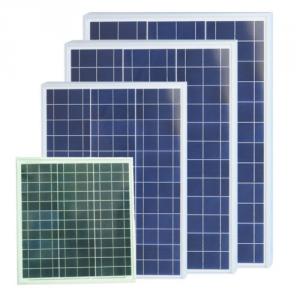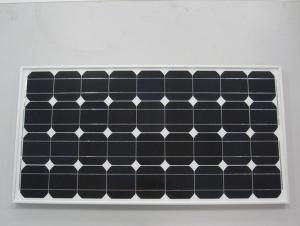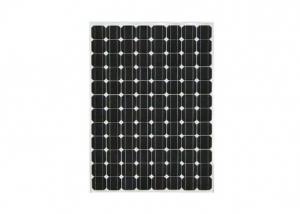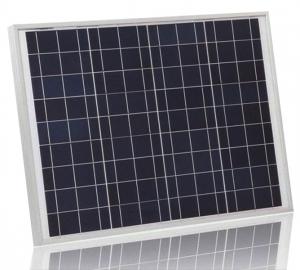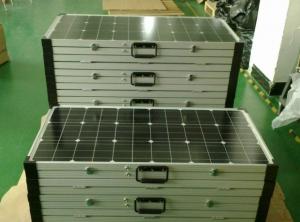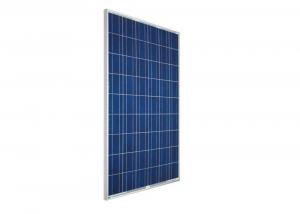Business-Grade Monocrystalline Silicon Solar Panels
- Loading Port:
- Shanghai
- Payment Terms:
- TT
- Min Order Qty:
- 1 watt
- Supply Capability:
- 100000/month watt/month
OKorder Service Pledge
OKorder Financial Service
You Might Also Like
CNBM Solar Mono Panels
Description of Monocrystalline Silicon Solar Panel
CNBM Solar photovoltaic (PV) Panel is designed for large electrical power requirements. It is the optimal choice for both on-grid and off-grid power systems. CNBM Solar panel offers high performance of power per square foot of solar array. Monocrystalline silicon(c-Si): often made using the Czochralski process. Single-crystal wafer cells tend to be expensive, and because they are cut from cylindrical ingots, do not completely cover a square solar cell module without a substantial waste of refined silicon. Hence most c-Si panels have uncovered gaps at the four corners of the cells.
Characteristics of Monocrystalline Silicon Solar Panel
I Solar Cell : High efficiency crystalline solar cell. Even if under the weak light, the solar module can produce maximum power output.
II Tempered glass (toughened glass): Anti-reflecting coating and high transmission rate glass increase the power output and mechanical strength of solar module.
III EVA and TPT: Using high quality EVA and TPT to prevent destroying and water.
IV AI frame: Without screw, corner connection. 6 holes on the frame can be installed easily.
V Junction box: Multi function junction box with water proof.
VI Long lifetime: ≥25 years; Less power decrease.
VII Good performance of preventing from atrocious weather such as wind and hails.
VIII Resisting moisture and etching effectively, not effected by geology.
Standard Test Conditions of Monocrystalline Silicon Solar Panel
The opto-electrical specifications shown below are stabilized values being measured at Standard Test Conditions, Irradiance: 1000W/m2, Spectrum: AM1.5 at 25°C, The info below is subject to manufacturing tolerances. Where appropriate minutes of measurement are available and are used for the dimensioning of the installation.
Advantages of Monocrystalline Silicon Solar Panel
• CNBM Solar performance guarantees for 25 years
• 2 years guarantee for workmanship
• Timeliness of delivery
Delivery of Monocrystalline Silicon Solar Panels
• 108 piece per pallet
• 22 pallets per container
CNBM International Corporation's products including Monocrystalline Solar Panel, Polycrystalline Solar Panel have received and enjoyed famous reputation in many countries and regions in the world .As a solar panel supplier in China, we strive to provide our customers with excellent service, superior products and unmatched value.
Characteristics
Power | 30W | 35W/40W |
Dimension | 440×550×25mm | 530×550×30mm |
Weight | 3.2kg | 3.8kg |
Tolerance | ±3% | ±3% |
The dimension of the modules can be changed according to the demand of clients
Limits
Operating Temperature | –40 °C to +85°C |
Storage Temperature | –40 °C to +85°C |
Max System Voltage | 700V |
Guarantee
Products Guarantee | 2 yrs free from defects in materials and workmanship |
Performance Guarantee | No less than 90% within 10yrs and no less than 80% within 25yrs |
Certificates | IEC, ISO, TUV, CE |
The Professional Production Line1
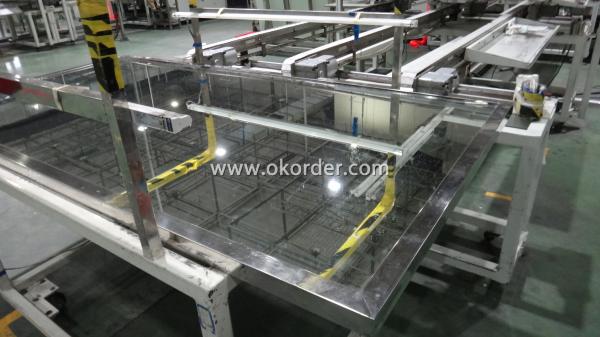
The Professional Production Line 2
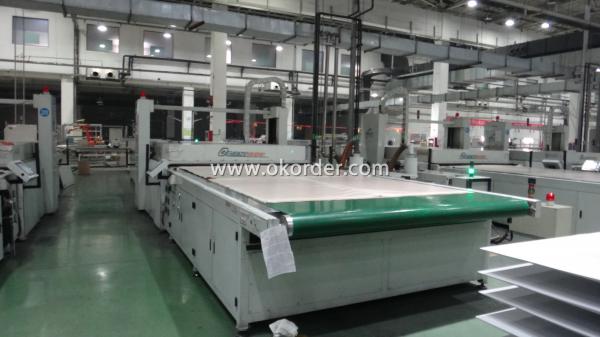
- Q: solar panel capacity, how do it work
- Well Capacity is totally depends upon quantity of panels and size of panels. You can install panels according to your requirements.
- Q: How do solar panels impact the aesthetics of a building?
- Solar panels can have both positive and negative impacts on the aesthetics of a building. On one hand, solar panels can enhance the visual appeal by adding a modern and sustainable look to the structure. They can be integrated seamlessly into the design, giving the building a contemporary and eco-friendly appearance. On the other hand, some people may find solar panels visually unappealing or out of place, especially if they are not well-integrated or if they differ significantly from the building's architectural style. Ultimately, the impact on aesthetics will depend on the design and placement of the panels, as well as individual preferences.
- Q: Got a quote for about $K today for solar panels to save me about $00 a month on my electric bill. I was just wondering if anyone had successfully bought and installed their own and how it worked for you?
- i do no longer yet i comprehend lots on the venture. e mail for information. a great number of ppl set up them yet just to cover there electric powered warmth/air. It saves them money. i comprehend lots of people who've tiny ones exterior there window to means the lights fixtures in that one room. Its no longer an eye fixed sore the two. i stay in Canada.
- Q: I jotted down some notes for my Technology and Architecture class and I'm trying to figure out what i meant when i said 'Treated with gases at extremely high temperatures.' I have NO idea what I was talking about :) Im trying to figure out if what I am talking about is about Silicon, Polychristaline, or a Solar Cell/Panel.
- Some steps in making semiconductors use gases at very high temps, and solar cells might.
- Q: What is the average annual energy output of solar panels that can be installed on the home?
- The energy output is highly dependent on the location. For a specific area, you can look up the equivalent peak sun hours per day here: rredc.nrel /solar/old_data/nsr... Let's say that it says the peak sun is 5 hours / day in your location. Then a typical 200-watt panel would have 5 x 200 = 000 wH = .0 kWh per day, or 365 kWh annually. The tables above already take into account average cloudy days, and seasons. A typical size installation would have perhaps 6 of these panels, but it could be less, or much more.
- Q: Can solar panels be installed in urban areas?
- Yes, solar panels can be installed in urban areas. In fact, they are increasingly being installed on rooftops, facades, and even integrated into buildings in cities around the world. Urban areas offer ample opportunities for solar panel installation, promoting clean energy generation and reducing dependence on fossil fuels.
- Q: could any tell me what type off panel is the best tube or flat and how much it should be. I live in N Ireland
- My solar thermal installation uses a 30-tube NAVITRON panel. This has an effective area of 2m2 and produces enough hot water in summer for 3 showers and plenty of washing up! I estimate that, in it's first year, it has saved me about ?60 in gas. The panels and prices are shown in the attached link. Mine was fitted by a professional installer for ?2500, including a huge, new cylinder (dual coil) to store the extra hot water. Flat panels are much less efficient than vacuum tube collectors. While flat panels are frequently cheaper, these Navitron panels are such good value that I think buying inferior, flat panels would be a false economy.
- Q: Can solar panels be installed on historical landmarks or monuments?
- Yes, solar panels can be installed on historical landmarks or monuments with careful planning and consideration to preserve the architectural integrity and cultural significance of the site.
- Q: China is the world's biggest producer of solar panels
- America should be making the panels and imposing large tariffs on any country trying to import theirs here.
- Q: i just took a trip to florida, they are cutting down anything that doesnt float and putting up buildings. Most of these cost a bundle, bill gates may pay cash for them, but most people will have many payments. Since pools, satellite dishes, and docks if near the water seem to be standard issue, why not a couple solar panels and water heater. It is florida after all, and if you are allready paying a half million or so for a house, what is another 0k gonna mean to you. Why dont they make it mandatory to include these on all new housing and condos and businesses. With that many the price would come down quickly and pay for itself long before the house is payed off and/or florida is flooded due to global warming.
- Solar Panels in housing developments is not being used because it would add $25,000 to $40,000 to the price of the home. Most people in the USA don't understand that after a few years the solar electric panels will start paying them back. It is not just the upfront cost. People would rather spend that 40K on somthing smart like a new corvette. Which has no pay back at all then something stupid like solar electric and helping themselfs or the rest of the world. So if the builders were to add them to the house people would just buy from another builder and the one adding the solar roof tops would just go broke. The State would have to find a way to credit the buyer or buider enough to make it worth it. Is it not more fun to spend millions on finding out where Anna Smith is going to be barried? Or maybe billions on top of billions on War? If we had spend the money on solar that we have spend on Iraq alone we could have put solar on every roof top in the whole USA and had few billion left over. Think about it.. 200 million people in the USA with three to a home would be 66 million homes. It would have only cost 528 billions dollars to put a kWh Solar Electric system on each house in America. But that would be stupid. War makes more money. We don't want Exxon to go broke do we?
Send your message to us
Business-Grade Monocrystalline Silicon Solar Panels
- Loading Port:
- Shanghai
- Payment Terms:
- TT
- Min Order Qty:
- 1 watt
- Supply Capability:
- 100000/month watt/month
OKorder Service Pledge
OKorder Financial Service
Similar products
Hot products
Hot Searches
Related keywords
